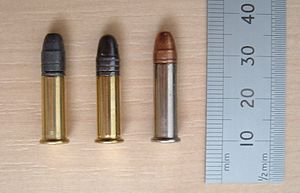.22 rifle
| .22 Long Rifle (.22 LR) | ||||||||||||||||||||||||
|---|---|---|---|---|---|---|---|---|---|---|---|---|---|---|---|---|---|---|---|---|---|---|---|---|

.22 Long Rifle – subsonic hollow point (left), standard velocity (center), hyper-velocity "Stinger" hollow point (right)
|
||||||||||||||||||||||||
| Type | Rimfire cartridge | |||||||||||||||||||||||
| Place of origin | United States | |||||||||||||||||||||||
| Production history | ||||||||||||||||||||||||
| Designer | J. Stevens Arms & Tool Company | |||||||||||||||||||||||
| Designed | 1887 | |||||||||||||||||||||||
| Specifications | ||||||||||||||||||||||||
| Parent case | .22 Long | |||||||||||||||||||||||
| Case type | Rimmed, straight | |||||||||||||||||||||||
| Bullet diameter | 0.223 in (5.7 mm) - 0.2255 in (5.73 mm) | |||||||||||||||||||||||
| Neck diameter | .226 in (5.7 mm) | |||||||||||||||||||||||
| Base diameter | .226 in (5.7 mm) | |||||||||||||||||||||||
| Rim diameter | .278 in (7.1 mm) | |||||||||||||||||||||||
| Rim thickness | .043 in (1.1 mm) | |||||||||||||||||||||||
| Case length | .613 in (15.6 mm) | |||||||||||||||||||||||
| Overall length | 1.000 in (25.4 mm) | |||||||||||||||||||||||
| Rifling twist | 1:16" | |||||||||||||||||||||||
| Primer type | Rimfire | |||||||||||||||||||||||
| Ballistic performance | ||||||||||||||||||||||||
|
||||||||||||||||||||||||
|
Test barrel length: 18.5" Source(s): |
||||||||||||||||||||||||
The .22 Long Rifle (metric designation: 5.6×15mmR) cartridge is a long-established variety of .22 caliber rimfire ammunition, and in terms of units sold is still by far the most common ammunition in the world today.
The cartridge is often referred to simply as .22 LR ("twenty-two-/ˈɛl/-/ˈɑːr/") and various rifles, pistols, revolvers, submachine guns and even some smoothbore shotguns (No. 1 bore) have been manufactured in this caliber.
American firearms manufacturer J. Stevens Arms & Tool Company introduced the cartridge in 1887 by combining the casing of the .22 Long with the 40-grain (2.6 g) bullet of the .22 Extra Long. The round owes its origin to the Flobert BB cap of 1845 through the .22 Smith & Wesson cartridge of 1857. It is one of the few cartridges that are accepted by a large variety of rifles, as well as pistols. The .22 Long Rifle and related cartridges (.22 Short, .22 Long, and .22 Extra Long) use a heeled bullet, which means that the bullet is the same diameter as the case, and has a narrower "heel" portion that fits in the case.
Low cost, minimal recoil, and relatively low noise make the .22 LR an ideal cartridge for recreational shooting, initial firearms training, small-game hunting, and pest control. Used by Boy Scouts in the United States for the rifle shooting merit badge, the cartridge is popular among novice shooters and experts alike. The rimfire round is commonly packaged in boxes of 50 or 100 rounds, and is often sold by the 'brick', a carton containing either 10 boxes of 50 rounds or loose cartridges totalling 500 rounds, or the 'case' containing 10 bricks totalling 5,000 rounds. .22 LR ammunition is among the least costly cartridge ammunition available.
...
Wikipedia
